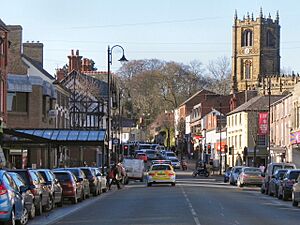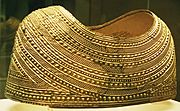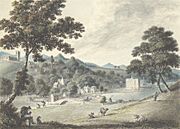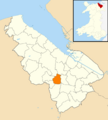Mold, Flintshire facts for kids
Quick facts for kids Mold
|
|
|---|---|
| County town and community | |
 Mold High Street, with St Mary's Church to the top-right. |
|
| Population | 10,058 (2011 census) |
| OS grid reference | SJ237640 |
| Community |
|
| Principal area | |
| Ceremonial county | |
| Country | Wales |
| Sovereign state | United Kingdom |
| Post town | MOLD |
| Postcode district | CH7 |
| Dialling code | 01352 |
| Police | North Wales |
| Fire | North Wales |
| Ambulance | Welsh |
| EU Parliament | Wales |
| UK Parliament |
|
| Welsh Assembly |
|
| Website | Town council |
Mold (Welsh: Yr Wyddgrug) is a town and community in Flintshire, Wales. It sits on the River Alyn. Mold is the main town and administrative center for Flintshire County Council. It was also the main town for Clwyd from 1974 to 1996. In 2011, about 10,058 people lived there.
Contents
What's in a Name? The Origin of "Mold"
The name "Mold" has an interesting history. It might come from the old Norman-French words "mont-hault," which means "high hill." Or, it could be named after a person, Robert de Montalt. In 1254, it was written as Mohald.
The Welsh name for the town is Yr Wyddgrug. This name was first recorded in 1280. It comes from three Welsh words: yr (meaning "the"), gwydd (meaning "tomb" or "burial place"), and crug (meaning "mound").
Mold's Past: A Journey Through Time

Just a mile west of Mold is a place called Maes Garmon. This is believed to be where a famous battle, the "Alleluia Victory," happened around AD 430. British forces, led by Germanus of Auxerre, fought against invading Picts and Scots.
Mold grew up around Mold Castle. This castle was a "motte and bailey" type, built by a Norman named Robert de Montalt around 1140. It was part of the Norman invasion of Wales. Welsh princes from the Kingdom of Gwynedd often tried to capture the castle to get their land back. For example, Owain Gwynedd took it in 1146. Later, Llywelyn the Great recaptured it in 1201.
English rule returned in 1241, but the Welsh prince Dafydd ap Llywelyn took the castle back in 1245. For a while, there was peace. Llywelyn ap Gruffudd built Ewloe Castle nearby, showing Welsh control. Mold Castle was seen as a "royal stronghold" under Welsh rule.
However, Edward I of England captured it in 1276-77. By the early 15th century, the castle's importance faded.
After the wars, English laws came to Wales. This helped Mold grow as a trading town. People set up markets and fairs. Farmers brought their animals to sell at the border between England and Wales.
But there were still tensions. During the War of the Roses, a Welsh captain named Reinalt ab Grufydd ab Bleddyn had many disagreements with people from Chester. In 1465, a big fight broke out at the Mold fair. Reinalt won and captured a former Mayor of Chester. In return, many armed men from Chester came to get Reinalt. He tricked them by hiding in the woods, then trapping some in his house and setting it on fire. He then chased the rest back to Chester.
By the late 1400s, powerful families like the Stanley family controlled Mold. Records from 1477 show that Thomas Stanley, 1st Earl of Derby had appointed a mayor and set up a courthouse in Mold.
Mold's Growth: From the 16th Century Onwards
In the 1530s, a historian named John Leland noticed that Mold's weekly market had stopped. At that time, Mold had about 40 houses and two main streets.
By the early 1600s, coal mining started to grow near Mold. This caused the town's population to increase. By the 1630s, there were over 120 houses in the area.
Queen Elizabeth I's government made Mold an important administrative center for Flintshire. By the 1760s, legal meetings were held there. The county hall was built in 1833, and a county jail in 1871.
In 1833, workers found a special golden cape while digging in a mound called Bryn yr Ellyllon (Fairies' Hill). This cape is from the Bronze Age (around 1900–1600 BC). It weighs 560 grams and was made from a single piece of gold. It broke when found, and pieces were shared among the workers. The British Museum bought the largest piece, and most of the other fragments were later found. The restored cape is now a famous treasure at the British Museum in London.
Mold has hosted the National Eisteddfod, a big Welsh cultural festival, several times: in 1923, 1991, and 2007.
Mold used to have a railway link to Chester, with a large station. However, this station closed in 1962 as part of the "Beeching cuts," which closed many railway lines in Britain. Today, a Tesco supermarket stands on the old station site. The closest train station now is Buckley railway station.
The Mold Riot of 1869
In the summer of 1869, a riot happened in Mold. This event had a big impact on how public disturbances were handled in Britain afterwards.
On May 17, 1869, the manager of a local coal mine, John Young, upset his workers by cutting their pay. He had also angered them by banning the use of the Welsh language underground. Two days later, miners attacked Young and took him to the police station. Seven men were arrested and put on trial. They were all found guilty, and two of the leaders, Ismael Jones and John Jones, were sentenced to a month of hard labor.
A large crowd had gathered to hear the verdict. The police and soldiers were present. As the arrested men were being taken to the train station, the crowd of 1,500 to 2,000 people became angry and threw things at the officers. The soldiers then fired into the crowd, sadly killing four people. One of them was Margaret Younghusband, a 19-year-old who was just watching.
An investigation was held, and the jury decided that the killings were justified. Later, other men involved in the riot were tried and sentenced to ten years in prison.
The famous Welsh novelist Daniel Owen, who lived in Mold, included similar events in his novel Rhys Lewis, published in the 1880s.
Getting Around: Transport in Mold
While Mold railway station closed in 1962, you can still travel by train from nearby stations. Buckley railway station has trains to Wrexham and Bidston. Flint railway station is also close and has direct trains to Cardiff, London, and Manchester.
Mold has frequent bus services during the day. You can catch buses from the bus station to places like Chester, Wrexham, Denbigh, Holywell, and Ruthin.
Cool Places to Visit: Mold's Landmarks
- Mold Town Hall was finished in 1912 and is a grand building.
- Loggerheads Country Park is a beautiful park located very close to Mold, great for outdoor activities.
- St Mary's Church, Mold is the town's main church. It's a historic building that dates back to the 15th century.
What Mold Offers: Amenities and Activities
Mold Library shares a building with the local tourist information office. Here, you can find out about things to do and even buy local arts and crafts.
Mold is a "cittaslow" town, which means it's part of a movement to make towns slower-paced and more enjoyable. It was the first town in Wales to get this special title!
The town has a lively street market every Wednesday and Saturday. You can find fresh produce and other goods there. For special local foods, check out the Celyn Farmers' Market, held on the first and third Saturdays of each month.
Every September, Mold hosts the Mold Food and Drink Festival. This is a big event with lots of local food and drink to try. In November, Mold also has its annual November Fest, a festival celebrating local beers, ciders, and wines.
Learning in Mold: Schools
Mold has two secondary schools for older students:
- Alun School is the largest school in the county, with about 1,800 students.
- Ysgol Maes Garmon is right next to Alun School. It's Flintshire's only Welsh-medium secondary school, meaning lessons are taught in Welsh.
For younger children, Mold has two primary schools:
- Ysgol Bryn Coch is the largest primary school in the county, with about 650 pupils.
- Ysgol Bryn Gwalia is another primary school.
- Ysgol Glanrafon is a bilingual school.
Local Businesses
Some companies are based in Mold, including NWN Media, which publishes The Leader newspaper.
Weather in Mold
Like the rest of the British Isles, Mold has a maritime climate. This means it has cool summers and mild winters. The nearest official weather station is at Loggerheads, about 3 miles west of Mold.
The highest temperature ever recorded in the area was 31.7°C (89.1°F) in August 1990. On average, the warmest day of the year is around 26.4°C (79.5°F).
The lowest temperature recorded was -18.7°C (-1.7°F) in December 1981. On average, the coldest night of the year is around -9.7°C (14.5°F). Mold usually has about 62 frosty nights each year.
Mold gets about 925 mm (36.4 inches) of rain each year. There are almost 152 days where at least 1 mm of rain falls.
Famous Faces from Mold
Many interesting people have connections to Mold:
- Jane Brereton (1685–1740), a poet born near Mold.
- Richard Wilson (1714–1782), a famous landscape painter and a founder of the Royal Academy, lived in Mold.
- Daniel Owen (1836–1895), a well-known Welsh novelist.
- Rhys Ifans (born 1967), an actor known for his roles in films, attended Ysgol Maes Garmon.
- Sian Gibson (born 1976), a comedy actress and TV writer.
- Rhodri Meilir (born 1978), an actor who grew up in Mold and went to Ysgol Maes Garmon.
- Rhiannon "Ritzy" Bryan (born 1985) and Rhydian Dafydd (born 1981), members of the band The Joy Formidable.
Sporting Stars
- Ron Hughes (1930–2019), a footballer who played many games for Chester City F.C..
- Simon Spender (born 1985), a football coach and former footballer with over 400 club games.
Images for kids
See also
 In Spanish: Mold (Gales) para niños
In Spanish: Mold (Gales) para niños







